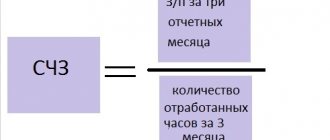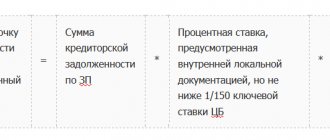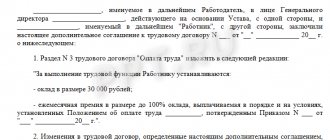04.07.2019
0
811
6 min.
Constantly changing conditions for the development of production and the lack of financial stability are pushing many private companies and enterprises to choose the most optimal wage system. One of them is a tariff-free procedure for settlements with employees of the organization. It allows for a more targeted distribution of earned funds among employees involved in the production process. This option is considered an alternative to tariff and piece-rate methods of calculation, since monetary remuneration is not tied to the amount of time worked, the qualifications of the employee, or the volume of products produced. Here, the KTU - labor participation coefficient - allows you to evaluate your individual contribution to the common cause.
Why is KTU needed?
IMPORTANT! Recommendations for establishing and applying the labor participation rate from ConsultantPlus are available here
The labor participation coefficient (LPC) is a quantitative indicator characterizing the degree of contribution to the overall labor process and the result of each participant.
It is used in those forms of organizing the labor process that imply collective participation. The result is achieved through joint efforts, but the payment must be assigned separately, so a measure is needed that serves as the basis for the distribution of rewards.
This is one of the forms of piecework payment , when the monetary remuneration paid to each employee depends on the quantity of products produced (in this particular case, the products were produced by the entire team), and on the price per unit of production.
REFERENCE . Most often, KTU is used in brigade forms of labor organization, when the earnings due to the entire team for work performed are distributed depending on the time worked and the qualifications of each employee.
How is KTU calculated? basic principles
- Compliance with labor discipline standards. If an employee is late for work and other violations, the KTU for him is reduced, and this will lead to a decrease in the final salary.
- Meeting deadlines for completing assignments. If they are completed on time or ahead of schedule, the CTU increases.
- Quality of work performed. It is determined by indicators for each specific type of activity; the employer must develop clear criteria for the quality of work performed so that employees clearly understand what result needs to be achieved.
- Performing overtime tasks. If workers show increased zeal and perform tasks beyond the plan, this is also rewarded according to the KTU.
- The desire to improve qualifications and grow professional skills. The employer is directly interested in the professional growth of employees; their desire to improve their skills should be financially encouraged.
- Mentorship of young employees. participation in mentoring programs. Encouraging mentors improves the training of young staff, which is beneficial for any enterprise, so such work must be encouraged.
Passivity, failure to meet deadlines, a decrease in the quality and pace of work, and disinterest in achieving results by the team can lead to a decrease in the employee’s performance level. In practice, the coefficient is often reduced for lateness, unnecessary breaks, absenteeism and other violations; this is one of the effective disciplinary measures.
KTU at established tariffs
The labor participation coefficient is taken into account not only when organizing the payment of labor remuneration without tariffs. Another area of application of the CTU is the distribution of part of the labor remuneration fund, which is not included in the established tariffs. Such components of wages may include:
- a bonus paid for achieving any indicators above the norm;
- saving money from the salary fund;
- a one-time payment as a result of revision of temporary or other standards, etc.
With such an accrual, the part that is due under the tariffs is deducted from the earnings of the entire team, and the remaining amount is distributed in accordance with the KTU.
IMPORTANT! Whether tariffs are applied in a given labor organization system or not, KTU can only be applied in a collective form of work.
What is KTU and how is it determined
The concept of “labor participation rate” is not directly spelled out in labor legislation. Because of this, each organization calculates it differently, and this sometimes leads to violations by the employer. KTU is defined as the numerical coefficient of participation of a particular employee in the activities of the group, as well as the share of remuneration that this employee should receive. However, the final result depends on collective efforts, so the final salary depends not on one employee, but on the team.
The principle of calculation according to KTU is most often applied to various production specialties, as well as to construction teams
It is important to take this into account. that KTU can only be accrued as an incentive in addition to the basic salary specified in the contract
An employer has no right to reduce an employee's salary. unless there are special reasons for this, such as changes in working hours and the nature of the work performed.
This indicator applies to all kinds of incentive payments, bonuses and allowances with which the team is rewarded for the results achieved. The final salary cannot be less than the amount that was specified in the employment contract.
Distribution of funds by KTU
Depending on the form of payment for group work, the KTU is applied as follows:
- with a non-tariff system : the total amount intended for payment for the entire team is divided by the number of workers, and then this average indicator, corresponding to indicator 1, is adjusted based on the KTU;
- when distributing payment in excess of tariffs : employees receive a “fixed” amount according to the tariff, and the remaining funds are divided taking into account the KTU.
Is it necessary to prove the fact of the appointment of the CTU, depending on the employee’s contribution - the fulfillment or non-fulfillment of his labor duties to one degree or another? View the court's opinion
Core differences between existing systems and forms of remuneration
The tariff system today remains the most familiar and optimal for most organizations. It seems more profitable for workers, since payment terms are determined before work begins and are not determined by the final result. In contrast, the tariff-free system is more attractive to employers. The reasons are obvious: this option of remuneration is interconnected with the results of the workers’ labor, the calculation is carried out after the work is completed, when there are concrete results.
The main criterion for distinguishing the piecework form of remuneration from the time-based form is the method of recording labor costs. Piecework is based on taking into account the number of finished high-quality products (and the volume of work - the number of operations). In the time-based form, the actual time worked is taken into account.
Where KTU cannot be used
Teamwork is the main condition for the use of CTU. The labor participation rate cannot be applied to any form of individual payments. Forms of remuneration where the CTU is fundamentally inapplicable include:
- compensation for hazardous work;
- overtime payments;
- additional payment for working on a holiday or day off;
- money for work on the night shift;
- additional amounts for supervision, mentoring, leadership of a team or department;
- bonuses for qualifications and experience;
- awards for improvement proposals or professional insights;
- all types of benefits.
Criteria
The indicator can decrease or increase depending on the individual contribution of each employee, his contribution to the overall result. Each organization has its own coefficient criteria. The procedure for determining and applying the labor participation coefficient must be submitted to a team meeting with the corresponding minutes drawn up.
When does the ratio decrease? These are cases such as:
- failure to comply with management orders;
- violation of production technology;
- failure to fulfill the established plan and indicators;
- faulty work or poor quality;
- violation of discipline;
- violation of labor protection conditions;
- performing work without instructions or permission;
- use of faulty equipment;
- use of equipment for purposes other than its intended purpose, etc.
When does the coefficient increase? These are the following cases:
- expression of initiative, activity;
- solving a responsible task;
- completing work in a short time;
- patronage, etc.
When applying the KTU, additional payments are distributed as:
- bonuses for performing work above the established norm;
- bonuses due to changes in regulations;
- savings on wages due to the release of employees.
Who installs KTU
The Labor Code of the Russian Federation does not have regulations regarding the calculation of earnings according to the KTU; this issue is left to the discretion of the workforce. The algorithm can be anything, the main thing is that it does not contradict the current provisions of the Labor Code and other legislative acts.
IMPORTANT INFORMATION! No matter how the earnings are distributed, the amount received by each member of the team cannot be less than what is required according to the tariffs for such work performed within a specified period of time.
Advantages and disadvantages
The advantages of using the CTU include the objective distribution of money between the participants in the process. Of course, only if objective quantitative indicators are taken into account, and not the degree of relationship or friendship with the leader. Another positive is that employees strive to improve their performance and contribute to business growth.
For managers, this is an opportunity to identify problem areas in the overall process and for each subordinate and correct them. For employees - a clear understanding of the requirements for the tasks performed.
The disadvantages include discord in the team. Even with objective differences in the work of employees, misunderstandings, envy and conflicts can arise. The result is an outflow of personnel.
This also includes the lack of a real picture. Employees can agree among themselves to divide the results evenly among all participants. In this case, management will not be in the know.
For example, when working with a cash register, sales are recorded under the selected person. Managers can calculate the numbers and “finish off” the goods for the seller who does not reach the average KTU.
To avoid the negative impact of the indicator on the team, you need to define clear criteria. They must be transparent and understandable to every member of the team.
Digital value of KTU
The basic value of the labor participation coefficient is taken as one. Indicator 1 means that a member of the work team, performing joint work, fulfilled all the requirements, was able to comply with the standards for temporary, quantitative and qualitative characteristics, while not making mistakes that worsened the overall result, and strictly complied with the requirements of discipline and labor protection.
When calculating, the resulting figure may be in the range from 0 (a team member did not participate in the overall work or committed serious violations that reduced his overall benefit to nothing) to 2 (more was completed than provided for by the standards of time, quantity and quality).
At the end of each period of work of the team (team), the KTU of each worker is calculated using a special protocol according to the established methodology. KTU criteria should be established as objectively as possible (they can be “specific” for each individual enterprise).
An example of remuneration calculation according to KTU
Let our conditional team have five workers engaged in making stools for a set time period. For the implementation of the plan, their team is entitled to payment of 1000 monetary units (let’s take a conditional value for calculations).
The first employee fully fulfilled the plan, complied with all standards, working the required number of working hours, that is, his KTU is equal to 1.
The second employee exceeded the norm by a quarter, the rest of the indicators are the same as the first. KTU will be 1.25.
The third employee fulfilled the quota, but due to his fault (failure to comply with the rules for working with equipment), the woodworking machine was broken, which forced the suspension of work. In addition, he was late for the start of the work day several times. Therefore, several points were deducted from him, and his CTU was 0.5.
The fourth employee fixed a breakdown in a woodworking machine; his qualifications allowed him to do this. He was given points for equipment maintenance; in addition, management noted the quality of his work, and his KTU turned out to be 1.6.
The fifth employee asked for time off on his last day of work. His work did not cause any complaints, but in fact he worked somewhat less than the others, so the KTU decreased to 0.65.
Now let’s calculate the share of each employee that he will receive with a non-tariff payment method, or the additional remuneration due as extra income, with an established “fixed” tariff.
The sum of all KTUs: 1 + 1.25 + 0.5 + 1.6 + 0.65 = 5.
With tariff-free payment, the total amount will be distributed as follows: 1000 / 5 = 200 (average share corresponding to a KTU unit). Then employees are entitled to:
- The 1st employee will receive 200 (account units);
- 2nd – 200 x 1.25 = 250;
- 3rd – 200 x 0.5 = total 100;
- 4th – 200 x 1.6 = 320;
- 5th – 200 x 0.65 = 130.
Thus, thanks to KTU, earnings were distributed unevenly, with some employees receiving significantly more than others. However, this is due to objective factors, and therefore will not cause a feeling of injustice and discontent in the team.
Formula for calculating the labor participation rate
To calculate the CTU, you need to use a system of established parameters, each of which is assigned its own “score”. The employee is assessed for each parameter, receiving a certain number of points for each in turn. The number of points is summed up.
To apply the formula, you also need to know the exact number of employees into whom the total participation will be divided. The calculation can be done like this:
KTU = (O / O1 + O2 +…+ Оn) x N
Where:
- KTU – labor participation coefficient;
- O – rating assigned to the employee whose participation rate is being calculated;
- О1 + О2 +…+ Оn – sum of points of all employees;
- N – number of team members.
Definition
What is meant by the labor participation rate and where is it applicable?
KTU is a digital value that reflects the assessment of the participation of each team member in work activities. This indicator is used to stimulate payments in a collective form of labor organization, as well as to show the contribution of employees to the result of work.
KTU is applicable as a weighting factor for the distribution of funds received as a result of collective work.
The most common case of using the indicator is the work of a team. Here the result is achieved through joint efforts, and the KTU (labor participation coefficient, calculated according to the established standards of each team member) shows which of the workers performed their functions in what manner.
Features of calculating KTU
Let’s imagine a team for which the following parameters for assessing its work have been developed:
- complexity of the work (on a three-point scale: the most difficult work - 3 points, average - 2 points, easy - 1 point);
- time load (maximum – 3 points, average – 2 points, minimum – 1 point);
- work on equipment (1 point for each type);
- equipment maintenance (2 points for each case);
- quality (1 point for compliance and 1 point for control);
- responsibility for results (up to 3 points, may be deducted for violations).
The Excel computer program is convenient for calculating KTU, where all indicators are visible in tabular form, and the last column displays the total for each employee.
Criteria for increasing and decreasing the indicator
The indicator is established when the production tasks of the enterprise are fulfilled without violations of labor discipline and exactly on time by the manager.
There are several criteria for increasing and decreasing the coefficient.
Raising:
- The team takes the initiative to master advanced technologies and workplaces, which significantly reduces labor costs (+0.2 +0.4).
- Increasing the intensity and efficiency of the team to reduce the established deadlines for completing the task (+0.2 +0.4).
- An employee’s performance of complex procedures, initiative to combine several professions, or assistance in work activities to other employees of this team (+0.1 +0.3).
- Carrying out activities that do not correspond to the qualification level, but performing tasks that are an order of magnitude higher (+0.1 +.0.3).
Downgrades:
- The assigned task was not completed on time (-0.2 -0.4).
- Marriage in the process of work, which determines the possibility of high labor costs (-0.2 -0.4).
- Failure to complete the order (-0.1 -0.3).
- Violation of the rules of operation and operation of mechanized production and equipment (-0.2 -0.5).
- Damage or loss of working tools (-0.3 -0.5).
- Activities that do not comply with safety and health regulations (-0 -0.5).
- Disciplinary violations of the production regime (-0.2 -0.5).
- Missed workday (0).
- Disciplinary violation of the customer's rules (-0 -0.5).
Newsletter from the magazine "Salary"
Guided by Art. 63 of the Labor Code of the Republic of Belarus (hereinafter referred to as the Labor Code), employers, on the basis of a collective agreement, use the labor participation coefficient (hereinafter referred to as the Labor Participation Coefficient) in remuneration of workers.
Let us consider the practice of its application in a construction organization that has within its structure the production of building structures and products. Approval of the regulations on the application of KTU The regulation on the application of KTU in a construction organization (hereinafter referred to as the Regulations) is approved by the employer in agreement with the trade union.
The position is an integral part of the organization's remuneration system.







